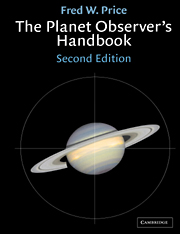Book contents
- Frontmatter
- Contents
- Foreword
- Preface
- Acknowledgements
- Abbreviations used in this book
- Introduction: Why observe the planets?
- 1 The Solar System
- 2 The celestial sphere
- 3 Telescopes and accessories
- 4 The atmosphere and seeing
- 5 Mercury
- 6 Venus
- 7 Mars
- 8 The minor planets (asteroids)
- 9 Jupiter
- 10 Saturn
- 11 Uranus
- 12 Neptune
- 13 Pluto
- 14 Constructing maps and planispheres
- 15 Planetary photography and videography
- 16 Photoelectric photometry of the minor planets, planets and their satellites
- Appendix: Milestones in Solar System exploration
- Name index
- Subject index
15 - Planetary photography and videography
Published online by Cambridge University Press: 05 August 2012
- Frontmatter
- Contents
- Foreword
- Preface
- Acknowledgements
- Abbreviations used in this book
- Introduction: Why observe the planets?
- 1 The Solar System
- 2 The celestial sphere
- 3 Telescopes and accessories
- 4 The atmosphere and seeing
- 5 Mercury
- 6 Venus
- 7 Mars
- 8 The minor planets (asteroids)
- 9 Jupiter
- 10 Saturn
- 11 Uranus
- 12 Neptune
- 13 Pluto
- 14 Constructing maps and planispheres
- 15 Planetary photography and videography
- 16 Photoelectric photometry of the minor planets, planets and their satellites
- Appendix: Milestones in Solar System exploration
- Name index
- Subject index
Summary
General
In addition to visual planetary observation and recording of observations by drawing, the amateur astronomer may also wish to record observations by photography. Until fairly recently, planetary photography involved the use of conventional photographic film exclusively as the recording medium but with the advent of video photography (videography) and the availability of charge coupled devices (CCD), astronomical photography in general has undergone a revolution. The principles of each of the types of planetary photography will be described here.
The planetary photographer's camera
The best kind of camera to use for planetary photography is any one of the many makes of 35 millimetre single lens reflex (SLR) type, the majority of which will be found suitable for this kind of work. Whatever make of SLR you choose, it should have the following features:
Removable lens.
It should have a ‘bulb’ or ‘time’ exposure.
The focusing screen should be as clear as possible to facilitate critical focusing.
There must be a suitable socket or other provision for attaching a cable release.
The shutter should operate quietly and smoothly with minimal vibration of the mirror.
Small and moderate-sized high-quality telescopes reveal an astonishing amount of detail on planetary discs but when attempts are made to capture the detail on photographic film the result is usually disappointing. Something always seems to be lost as compared with what can be seen by direct visual observation.
- Type
- Chapter
- Information
- The Planet Observer's Handbook , pp. 383 - 404Publisher: Cambridge University PressPrint publication year: 2000



